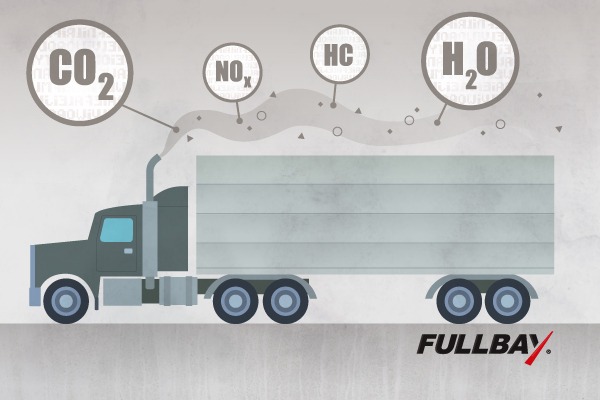Heavy Duty Truck Emission Standards

The EPA has been regulating vapors and fumes vehicles give off since the mid-1970s. Better air quality and improved health for U.S. citizens is the goal. In 2004, the agency set down new rules for heavy duty truck emission standards. They gave truck makers the next 6 years to apply them. As of 2010, 100% of new diesel engines had to meet the EPA’s terms. It’s been almost a decade since the final phase went into effect. Although those strategies have been costly, driving up price tags on new semi trucks, the plan seems to be working. Overall, the EPA reports a drop in harmful emissions such as carbon monoxide, nitrogen oxide (NOX) and sulfur dioxide in the air.
Brief Overview of Heavy Duty Truck Emission Standards
Although the first EPA emission limits date from 1974, new, stricter limits get published every few years. Currently, heavy duty CI engines must meet the 2007 rules. In 2007, half of the new engines sold had to meet the NOX heavy duty truck emission standards. That applied to model year trucks 2007 and newer. Plus, all of them had to meet the particulate matter (PM) standards. By 2010, 100% of new engines (MY 2010 and newer) had to meet all standards. Though there is no official 2010 mandate, “2010 standards” refer to the most recent fully phased-in rules.
California Always Ahead of the Curve
In the table above, the 1987 figure listed for PMs applied only to the state of California. There was no federal PM rule at the time. Plus, in 1991, the Golden State set a lower limit on PMs for urban buses, too—.10 g/bhp·hr. In fact, California typically sets down more stringent requirements than the rest of the country. Additionally, the state routinely adjusts their schedule earlier than federally required. It often enforces heavy duty truck emission standards a few years early. What’s more, in 2014, the California Air Resources Board added an elective standard to the mix for heavy duty engines. It’s called the Optional Low NOX Standard. Truck builders have the choice of certifying their engines to three NOX standards:
- .10 g/bhp·hr
- .05 g/bhp·hr
- .02 g/bhp·hr
Improved Air Quality
Better air quality via the EPA’s heavy duty truck emission standards couldn’t happen right away. Upon releasing the 2007/2010 rules, the EPA predicted it would take until 2030 to see full benefits from complete implementation. During the interim 23 years, it’s projected that NOX emissions will decrease by 2.6 million tons per year. Additionally, the EPA estimated a drop in:
- PMs by 110,000 tons/year
- benzene and other toxic air pollutants by 17,000 tons/year
- hydrocarbons by 115,000 tons/year
Useful Life and Warranty Periods
At first, trucks had to comply with the heavy duty truck emission standards during the useful life of the engine. Both California and the federal government initially set the same numbers:
- 8 years or 185,000 miles (whichever happened first) for medium heavy-duty diesel engines
- 8 years or 290,000 miles for heavy heavy duty diesel engines
However, the Fed upped the useful life requirement, making it 10 years. The mileage numbers remain the same.
Tech Options
Tech advances offer new options to help manufacturers comply with the 2007 heavy duty truck emission standards. First, catalyzed particle filters were used for the PM standard. Second, cool exhaust gas recirculation helped meet the short-term NOX standard. Since phasing in the permanent standards (achieved in 2010) truck builders currently use selective catalytic reduction (SCR) technology. Said to reduce NOX as much as 90%, SCR uses diesel exhaust fluid (DEF) to create oxidizing ammonia in the exhaust flow.
However, inventors have turned an eye to building trucks that do better than just reduce emissions. Companies like Thor and Nikola are ready to roll out state-of-the-art semis that make the most of cutting-edge tech, claiming zero emissions for easy 100% compliance.
Fuel for Meeting Heavy Duty Truck Emission Standards
In addition to building engines to perform cleaner, burning cleaner fuels is another way to reduce emissions. The EPA encouraged this by adding an optional rule for vehicles with 1998 to 2003 MY engines that allowed manufacturers a Clean Fuel Fleet (CFF) certification. Five years before, in 1993, a cap had already been set that limited sulfur in diesel fuel to 500 ppm. More recently, in 2006, the EPA began requiring refiners to produce 15 ppm S fuel. Such a drastic change took time. Gradual implementation was allowed throughout the summer of 2006. Additionally, the EPA offered a short-term option. It allowed refiners to produce up to 20% of their total fuel as 500 ppm up until December 31, 2009.
But developers with an eye on helping fleets meet heavy duty truck emission standards continue to look for other types of fuel. Liquid natural gas (LNG) is one substitute going through testing. Early results are inconclusive, and developers need to find ways to make it safer and further cut LNG emissions. Still, LNG remains on the radar as a possible diesel alternative.
Testing Trucks
Drivers and fleets prove their semis meet the EPA’s current heavy duty truck emission standards with routine testing. It must be done over the engine’s transient engine dynamometer cycle. Plus, as of 1998, on top of emission testing, semis have to go through two additional tests. First, the Not-To-Exceed (NTE) test assesses driving that might take place within an NTE control area. The test includes transient and steady-state conditions (such as a heavy duty truck driving on a freeway). It also takes various road and weather conditions into account. The Supplemental Emission Test (SET) is the second extra test. It examines trucks’ emissions while steady-state driving. Federal regulations require these tests on engines MY 2007 and newer. California’s rules require them for MY 2005 and newer.
Staying on Top of Heavy Duty Truck Emission Standards
Heavy duty techs can opt to certify as emissions technicians to help keep fleets in compliance. The course gives in-depth training on exhaust systems as well as up-to-date knowledge on heavy duty truck emission standards. It gives fleets and repair shops an edge to have an emissions tech on staff.
Plus, a well-maintained semi runs better and more efficiently. That’s why, whether your techs are emissions specialists or not, keeping trucks in top working order helps ensure heavy duty truck emission compliance. Doing preventive maintenance on a regular basis is easier with the help of fleet tracking software like Fullbay. It tracks vehicle history much like a medical record. With the click of a button, you can pull up tons of data. Maintenance schedules, repairs, parts and products used, vehicle performance, and vehicle age including make, model, and MY, for example. Fill in the form below for a demo and see how Fullbay can help keep your trucks in compliance.

